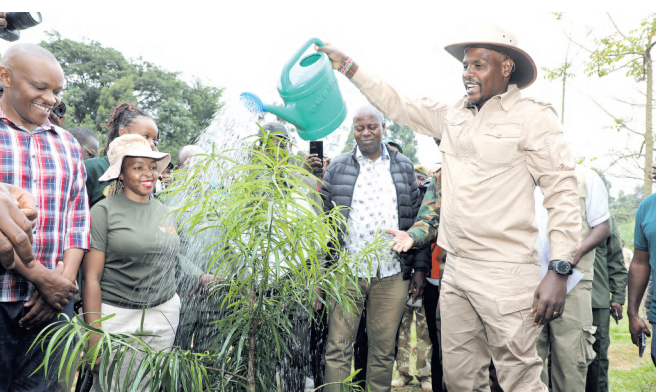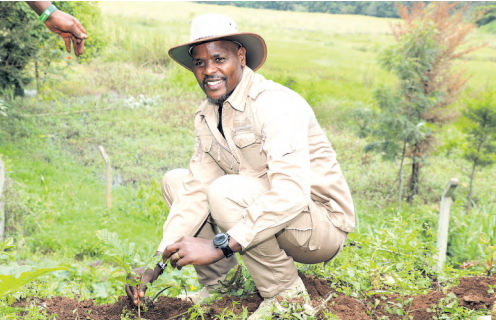

Prof David Ngugi has dedicated most of his life to conserving and protecting the Ondiri catchment as well as the swamp itself.
“I was born here, around Ondiri more than 85 years ago, and have seen it change over that period,” the professor, who also has a farm near Ondiri wetland, says.
At Independence, he says, Ondiri was surrounded by three major white farmers’ farms, and it was a permanent, fully water-covered environment. Thereafter, the big farms were broken down into smaller farms as farming and construction intensified.
“The demand for water increased, the use of pesticides has also increased and these have become a major threat to Ondiri in different ways,” Ngugi says.
The swamp became heavily polluted by settlements around the swamp. Moreover, there was a lot of siltation as the forest that previously surrounded the swamp had been cleared for agriculture and buildings. Birdlife suffered as well.
The birds Ngugi used to see as a boy while studying at Alliance Boys High School disappeared, including the crested crane.
Other wildlife that used to call the swamp home, such as waterbugs and colobus monkey, were also affected by human activities. Ondiri swamp was also threatened by increased obstruction of water through boreholes.
ESCALATING THREATS
Ngugi says they have since mounted a serious campaign to raise awareness about the importance of wetlands.
They started discouraging people from cultivating in the riparian area, educating them about suitable trees to plant in the riparian area.
Ngugi says they teamed up with officials from the agriculture sector before training riparian landowners on suitable crops, suitable practices and also further refuelling the catchment, teaming up with other actors on an efficient way of using water.
He says with time, those with farms around the riparian area adopted the use of drip irrigation instead of sprinkler irrigation.
Ngugi says a sewer system was later installed, which protected Ondiri swamp from constant pollution. He cites the fencing of Ondiri as one of the success stories.
The Ondiri wetland is located in Kikuyu town, Kikuyu subcounty, in Kiambu county, and covers 34.5ha with a perimeter of about 3.3km and with a depth of 3-4m.
The wetland forms the headwaters of Nairobi River, where it feeds into Nyongara river. It recharges the Kikuyu springs through a subterranean passage.
The wetland is a source to 40 others springs and supports biodiversity-aquatic, birds, mammals, reptiles and insects.
Within the wetland, 68 plant species have been recorded. It has 74 resident and migratory birds, such as the endangered Grey Crowned Crane.
A bird survey by Nature Kenya at the Ondiri swamp identified 124 bird species, including the Squacco Heron, Black-crownedNight Heron, Little Grebe and Grey Crowned Crane.
The wetland has 68 plant species (aquatic and semi aquatic). Common species include Typhadomingensis and Cyperus brevifolius.
There are about 11 species of invertebrates (insects), two species of amphibians and one species of fish in the swamp. Estimates indicate that close to 800 visitors visit the Ondiri swamp to watch birds, both domestic and international.
Ngugi says improvement of the environment is multifaceted as it has to include so many things, many actors, schools, churches, county government, farmers and ranchers. He calls for spreading the gospel of environmental protection to the future generation.

Ngugi says the Onkaru Water Resources Users Association is looking for resources to work with the schools surrounding the swamp to train them on rainwater harvesting and the benefits.
He has started growing indigenous trees in his farm to have a big forest that provides refuge to the birds.
“I have a big forest. I’ve been doing this for the last 25 years, and the birds that ran away from Ondiri have now come to my place,” Ngugi says.
“I’m arranging for bird watching at my farm. There are a few people who are lucky, they have a slightly bigger piece of land, where they can have woodland, where birds can shelter. “But generally, if you look at Kikuyu subcounty, it’s the most rapidly urbanising subcounty in the county.”
LAND SUBDIVISION
Ngugi says the rate of land subdivision is worrying, it is becoming a threat to biodiversity. It is for his ambitious efforts to protect and conserve nature that Ngugi was among those feted during World Wetlands Day, which was marked at Ondiri swamp.
The World Wetlands Day is celebrated annually on February 2 to mark the day of the adoption of the Ramsar Convection.
The convention is the intergovernmental treaty that provides the framework for the conservation and wise use of wetlands and their resources.
The World Wetlands Day is used to raise awareness on the importance of wetlands for people and the planet.
Environment CS Aden Duale said wetland ecosystems are vulnerable to uncontrolled human activities that hurt their ecological health.
In a speech read on his behalf by PS Festus Ng’eno, he said this consequently causing a loss of ecological functions.
“Encroachment on wetlands for agriculture, settlement, industrial and infrastructural development has led to a loss of many wetlands in our country and globally,” Duale said.
In Kenya, wetlands cover about 3-4 per cent of the country’s land surface area, which translates to around 14,000 square kilometers.
Ng’eno on his part hailed the adopt-a-wetland initiative, citing the example of Friends of Ondiri, who have adopted Ondiri wetland.
He said Nema has already developed a management plan for the wetland, and the gazettement process is ongoing to clear the wetland for consideration as a Ramsar site.
World Wide Fund for Nature-Kenya Rift Lakes Landscape programme manager Kevin Gichangi says even though wetlands cover only six per cent ot earth’s surface, they play a crucial role.
“Wetlands are very important for many reasons,” the programme manager says. “Forty per cent of biodiversity on earth is hosted by wetlands.”
Gichangi calls for a multi-sectoral approach to manage water resources. He says wetlands are crucial as they regulate water flow.
“When you look at the rivers in Kenya, some of them come from wetlands,” he says. “Ondiri Swamp, for example, is a source for Nairobi River, and wet lands act like a sponge. They keep water even during the dry season and release it slowly.”
Gichangi regrets that wetlands were previously viewed as wastelands, areas that are not productive or beneficial.
“But over the years, we’ve realised that losing wetlands means that we’re losing our livelihoods and also affecting the economy, not to mention biodiversity.” Gichangi says wetlands are worryingly being lost at an alarming rate.
“The statistics tell us we are losing wetlands three times faster than we are losing forests,” he says. Gichangi decried that despite Kenya having laws, enforcement is still lacking. “We have very many laws to protect wetlands,” Gichangi says.
“It is a call to Kenyans and all organisations and institutions to work
together to enforce them.”











